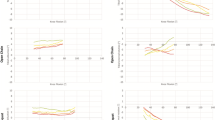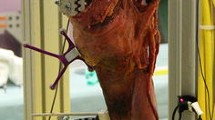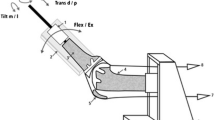Abstract
Purpose
Balancing mobile-bearing (MB) unicondylar knee arthroplasty (UKA) is challenging. If performed improperly, potential complications include pain, implant loosening, or progression of osteoarthritis in the preserved compartment. The purpose of this study was to document effects of improper balancing on knee kinematics and joint contact stress. It was hypothesized that over-stuffing would lead to more valgus and higher lateral contact force.
Methods
Seven fresh-frozen cadaver legs were mounted in a kinematic rig that applied three motion patterns to the specimens: passive flexion–extension, open chain extension, and squatting. During testing, an infrared camera system recorded the trajectories of markers rigidly attached to femur and tibia, while a pressure sensor measured contact pressure in the lateral compartment. Prior computer tomography scans allowed identification of coordinate frames of the bones and calculations of anatomical rotations and translations. Collateral ligament strains were calculated, and quadriceps forces recorded. Following testing on the native knee, a medial MB UKA was implanted in each specimen and all motion trials were repeated. Three inlay thicknesses were tested to simulate optimal balancing as well as under- (1 mm thinner) and over-stuffing (1 mm thicker) of the medial compartment relative to the optimal thickness.
Results
Under-stuffing of the medial compartment leads to kinematics closest to the native knee. Subjectively balanced and over-stuffed MB UKA knees were in more valgus. Lateral peak contact stress was higher from mid- to deep flexion following UKA in all three tested states; however, these results were not significant. Peak strain in the superficial medial collateral ligament (sMCL) was significantly higher in MB UKA, regardless of the inlay thickness mainly in mid-flexion. Inlay thickness had no significant impact on measured quadriceps force during squatting.
Conclusion
The results underline the importance of optimal balancing. Over-stuffing should be avoided as it results in the largest kinematic changes relative to the native condition and induces higher strains in the sMCL. Based on the kinematic findings, it is advisable to use thinner inlays, as long as this is not compromising stability or risking inlay luxation.





Similar content being viewed by others
References
Allaire R, Muriuki M, Gilbertson L, Harner CD (2008) Biomechanical consequences of a tear of the posterior root of the medial meniscus. Similar to total meniscectomy. J Bone Joint Surg Am 90(9):1922–1931
Brimacombe JM, Wilson DR, Hodgson AJ, Ho KC, Anglin C (2009) Effect of calibration method on Tekscan sensor accuracy. J Biomech Eng 131(3):034503
Cassidy KA, Tucker SM, Rajak Y, Kia M, Imhauser CW, Westrich GH, Heyse TJ (2015) Kinematics of passive flexion following balanced and overstuffed fixed bearing unicondylar knee arthroplasty. Knee 22(6):542–546
Collier MB, Eickmann TH, Anbari KK, Engh GA (2007) Lateral tibiofemoral compartment narrowing after medial unicondylar arthroplasty. Clin Orthop Relat Res 464:43–52
Collier MB, Eickmann TH, Sukezaki F, McAuley JP, Engh GA (2006) Patient, implant, and alignment factors associated with revision of medial compartment unicondylar arthroplasty. J Arthroplasty 21(6 Suppl 2):108–115
Duhamel A, Bourriez JL, Devos P, Krystkowiak P, Destee A, Derambure P, Defebvre L (2004) Statistical tools for clinical gait analysis. Gait Posture 20(2):204–212
Ettinger M, Zoch JM, Becher C, Hurschler C, Stukenborg-Colsman C, Claassen L, Ostermeier S, Calliess T (2015) In vitro kinematics of fixed versus mobile bearing in unicondylar knee arthroplasty. Arch Orthop Trauma Surg 135(6):871–877
Grood ES, Suntay WJ (1983) A joint coordinate system for the clinical description of three-dimensional motions: application to the knee. J Biomech Eng 105(2):136–144
Hernigou P, Deschamps G (2004) Alignment influences wear in the knee after medial unicompartmental arthroplasty. Clin Orthop Relat Res 423:161–165
Heyse TJ, El-Zayat BF, De Corte R, Chevalier Y, Scheys L, Innocenti B, Fuchs-Winkelmann S, Labey L (2014) UKA closely preserves natural knee kinematics in vitro. Knee Surg Sports Traumatol Arthrosc 22(8):1902–1910
Heyse TJ, El-Zayat BF, De Corte R, Scheys L, Chevalier Y, Fuchs-Winkelmann S, Labey L (2014) Biomechanics of medial unicondylar in combination with patellofemoral knee arthroplasty. Knee 21(Suppl 1):S3–S9
Heyse TJ, El-Zayat BF, De Corte R, Scheys L, Chevalier Y, Fuchs-Winkelmann S, Labey L (2015) Balancing UKA: overstuffing leads to high medial collateral ligament strains. Knee Surg Sports Traumatol Arthrosc. doi:10.1007/s00167-015-3848-5
Heyse TJ, Tucker SM, Rajak Y, Kia M, Lipman JD, Imhauser CW, Westrich GH (2015) Frontal plane stability following UKA in a biomechanical study. Arch Orthop Trauma Surg 135(6):857–865
Hobbs LW, Benezra Rosen V, Mangin SP, Treska M, Hunter G (2005) Oxidation microstructures and interfaces in the oxidized zirconium knee. Int J Appl Ceram Technol 2(3):221–246
Knutson K, Robertsson O (2010) The Swedish knee arthroplasty register (www.knee.se). Acta Orthop 81(1):5–7
Koskinen E, Paavolainen P, Eskelinen A, Pulkkinen P, Remes V (2007) Unicondylar knee replacement for primary osteoarthritis: a prospective follow-up study of 1,819 patients from the Finnish Arthroplasty Register. Acta Orthop 78(1):128–135
Lenhoff MW, Santner TJ, Otis JC, Peterson MG, Williams BJ, Backus SI (1999) Bootstrap prediction and confidence bands: a superior statistical method for analysis of gait data. Gait Posture 9(1):10–17
Lewold S, Robertsson O, Knutson K, Lidgren L (1998) Revision of unicompartmental knee arthroplasty: outcome in 1,135 cases from the Swedish Knee Arthroplasty study. Acta Orthop Scand 69(5):469–474
Muriuki MG, Tuason DA, Tucker BG, Harner CD (2011) Changes in tibiofemoral contact mechanics following radial split and vertical tears of the medial meniscus an in vitro investigation of the efficacy of arthroscopic repair. J Bone Joint Surg Am 93(12):1089–1095
Ridgeway SR, McAuley JP, Ammeen DJ, Engh GA (2002) The effect of alignment of the knee on the outcome of unicompartmental knee replacement. J Bone Joint Surg Br 84(3):351–355
ten Ham AM, Heesterbeek PJ, van der Schaaf DB, Jacobs WC, Wymenga AB (2013) Flexion and extension laxity after medial, mobile-bearing unicompartmental knee arthroplasty: a comparison between a spacer- and a tension-guided technique. Knee Surg Sports Traumatol Arthrosc 21(11):2447–2452
Victor J, Van Doninck D, Labey L, Innocenti B, Parizel PM, Bellemans J (2009) How precise can bony landmarks be determined on a CT scan of the knee? Knee 16(5):358–365
Victor J, Van Glabbeek F, Vander Sloten J, Parizel PM, Somville J, Bellemans J (2009) An experimental model for kinematic analysis of the knee. J Bone Joint Surg Am 91(Suppl 6):150–163
Acknowledgements
The study was funded by a German Knee Society grant (Deutsche Kniegesellschaft) and a research grant of the Rhön-Klinikum AG (Innovations- und Förderpool). The implants were donated by Biomet, Europe.
Author information
Authors and Affiliations
Corresponding author
Rights and permissions
About this article
Cite this article
Heyse, T.J., Slane, J., Peersman, G. et al. Balancing mobile-bearing unicondylar knee arthroplasty in vitro. Knee Surg Sports Traumatol Arthrosc 25, 3733–3740 (2017). https://doi.org/10.1007/s00167-016-4241-8
Received:
Accepted:
Published:
Issue Date:
DOI: https://doi.org/10.1007/s00167-016-4241-8




